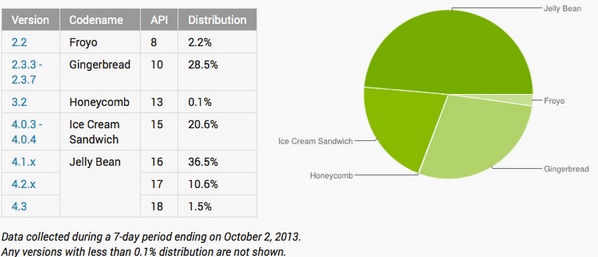Jellybean Now on Almost 50% of Android Devices
As we get closer to Android 4.4 KitKat’s release, fresh data from Google indicates that the problem of fragmentation on Android may be reducing in magnitude. Jellybean is apparently running on almost half of all Android devices right now.
Jellybean Dominating
According to Google, which maintains statistics and data of all Android devices that connect to the Play Store, 48.6% of all such devices are currently running ‘Jellybean’. Jellybean of course, isn’t just one version of Android, but three – 4.1, 4.2 and 4.3. While 4.1 Jellybean constitutes a majority of the share with 36.5%, 4.2 comes second with 10.1%. The newly released 4.3, so far only available on Nexus and Play Edition devices (and recently being made available on the HTC One) is at a tiny 1.5%
Versions 4.2 and 4.3 feature minor incremental upgrades over their predecessors, thus they don’t get themselves a unique name. So whether you believe the Android fragmentation problem is being solved is really a matter of perspective.
Gingerbread Persistent
Gingerbread, which has dominated Android devices for a very long time is now down to a 28.5% share. The number is still significant – it is second after 4.1 Jellybean, but the downwards trend would please both developers and Google.
3.2 Honeycomb is still persistent at 0.1%, while the ancient 2.2 Android version, called ‘Froyo’ is running on 2.2% of devices.
Android 4.3, currently at 1.5% is expected to increase its share in the coming times. The 4.3 update has begun pushing out to the HTC One, and Samsung has confirmed the update for 3 of its devices – Galaxy S3, Galaxy S4, and Note 2.
Other devices, like the HTC One S and One X will get their last update in the form of 4.2 Jellybean. Samsung’s hugely popular Galaxy S2 will remain at 4.1 Jellybean.
On the other hand, Apple’s iOS boasts of a much more successful story of update adoption. Apple’s previous iOS 6 was previously running on almost 96% of all iOS devices within a short period of release. The latest update – iOS 7 – is already on 65% of iOS devices and it’s only been 2 weeks since release.
Android’s next update – 4.4 KitKat – is expected to release this month along with the LG Nexus 5 (which was recently leaked in a bar) this month. The 4.4 also being an incremental upgrade over 4.3, it is being speculated that many devices may skip 4.3 altogether and move on to 4.4 directly.
How Data is Collected
Google collects statistics from Android devices that connect to the Play Store at least once a month. The current data has been compiled based on a 7 day period for the week ending October 2nd. This methodology expectedly leaves out many Android devices. Amazon’s Kindle line-up, for example, never connects to the Play Store, but to Amazon’s own stores, are not part of this data.
Moreover, a large amount of phones in China do not connect to the Play Store, but to third party stores and other sources. In fact, according to Benedict Evans, a mobile analyst, only 5.6% of all Android app installs originate from the Play Store. Evans further claims that 72.6% of all app installs are from third party sources.
I find that hard to believe. However, if that indeed is the case – the statistics we’re seeing from Google would be representing a very small number of Android devices. Perhaps it would be a good idea if Google releases the number of Android devices counted as part of its data. We have a fair idea of the number of Android devices in the world right now – Google’s Sundar Pichai claimed over a billion had been activated at on his Google+ page this September. This would give us a better insight into the fragmentation issue the platform faces.
Or maybe that’s exactly why Google doesn’t give us those numbers.


